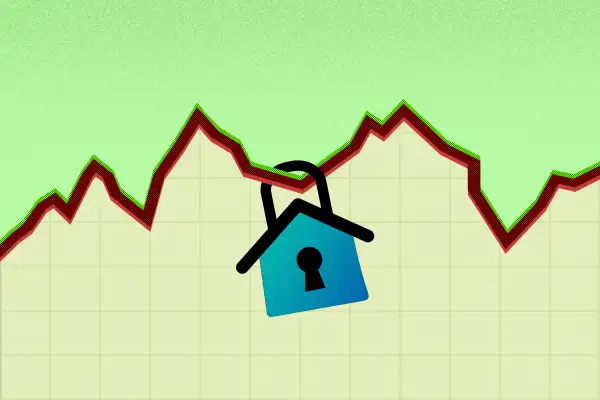Why a Rate Lock Makes Sense Right Now, Even with Mortgage Rates Falling

With interest rates falling, more borrowers are delaying mortgage rate locks. While it's tempting to try to time the market, mortgage experts say it could be a mistake.
Last week, the average 30-year loan clocked in at a mere 3.13%, according to mortgage purchaser Freddie Mac. That’s down from 3.84% one year ago and the fourth record-low rate since the start of March.
If experts are right, those rates may be here to stay—and could even go lower. Recent news from the Federal Reserve backs this sentiment: On June 10, the Fed announced it would keep the interest rates it charges banks near zero and continue aggressively buying mortgage-backed securities to help prop up the market.
Freddie Mac predicts a 3.3% rate for the fourth quarter 2020, while Fannie Mae’s economists actually see additional drops on the horizon. According to the company’s latest forecast, the average 30-year rate will fall to 3% by the fourth quarter of this year, eventually dipping into the 2% range come 2021.
Are rate locks smart in today’s market?
Typically, a new mortgage borrower would apply for what’s called a “rate lock,” often after the home they are purchasing has been appraised and inspected, to protect from market fluctuations until they close on the home. On refinances, borrowers usually lock their rate after their home’s appraisal is finalized. Most lenders will not charge to guarantee a rate for periods of 30, 45 or 60 days. Longer rate locks often cost extra for the borrower, though recently, some lenders have begun offering free, extended lock periods to cope with the surge in volatility and demand due to the coronavirus.
“Borrowers often worry that by locking in too early, they may miss the opportunity for a better rate before they complete a purchase or that they will have to pay extra to extend the lock to prevent it from expiring,” says Viral Shah, head of financial products at mortgage lender Better.com. “Conversely, some borrowers fear market volatility and lock in their rates as early as possible.”
Despite these worries, most experts say rate locks are still a smart idea—as long as you’ve secured a rate you’re comfortable with and can afford.
The alternative—or not locking the rate until closing—could mean paying significantly more in the long run. “The best rule of thumb is that if the numbers make sense, seize the opportunity. You can always refinance later on,” Shah says. “While rates are low today, we cannot guarantee that tomorrow’s rates will be higher or lower, and by waiting, you potentially risk missing out on benefiting from today’s historically low rates.”
The real risk
In the current environment, there is the chance that rates can go lower. But experts say that’s an easy fix: just re-lock the loan at a new rate. With some lenders, additional rate locks come with a fee—but not all. These tend to be about 0.5% to 1% of the loan amount—so up to $3,000 on a $300,000 mortgage. There are also “float-down” options, which allow you to seize a lower rate if the market changes during your lock period. These usually cost a few hundred dollars.
That cost may be well worth it, though. On a 30-year, $300,000 mortgage, even a 0.25 percentage point difference in rate—for instance, from 3.5% to 3.25%—can mean paying $30 less per month and more than $10,000 saved in interest over the course of the loan.
Therefore, the real risk often lies in not locking. “If rates go up and you’re not locked in, then that low rate is gone,” says Alan Rosenbaum, CEO and founder of mortgage originator GuardHill Financial. “Rates trend down very slowly, but trend up very fast.”
While tempting, trying to time your purchase or refinance to get the absolute lowest rate can be near impossible. Doing so when rates are already low has its own unique set of risks since lenders see increased business during these periods. “Mortgage rates are more determined by supply and demand,” says Rosenbaum. “If the lenders are really busy, they’re not going to lower their rates.”
Data from the Mortgage Bankers Association shows the number of purchase loan applications filed last week increased 18% compared to a year earlier. Refinance applications were up 76%, and according to Shah, Better.com alone has seen a 137% gain in refinance demand since March.
With this increased volume lenders are seeing, borrowers who do opt for a rate lock will want to make sure their lender can finalize the loan before their lock period expires. Though they won’t have much control over how long their loan takes, they can choose different lock lengths, so they’ll want to talk to their loan officer about possible processing times.
Is waiting worth it?
Rates are extremely low—and experts say waiting around for a lower one is not worth the risk for most borrowers.
According to Alex Elezaj, chief strategy officer at lender United Wholesale Mortgage, his company is currently offering 30-year conventional loans with rates as low as 2.5% and 2.99%—and even lower on 15-year loans—to borrowers with credit scores down to 640.
With rates that low, waiting for any further drop just doesn’t make sense.
“If rates are really low, you just take advantage of it and you close on it,” Elezaj says. “They could go up; they could go down. But when you're talking about rates in the twos, you start splitting hairs at that point.”
More from Money
With Mortgage Rates So Low, Getting a Floating Rate Mortgage Might Seem Crazy. Here's Why I Did It Anyway
What the Fed’s 0% Interest Rate Plan Means for Mortgage Rates
